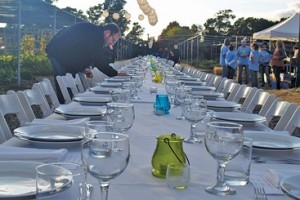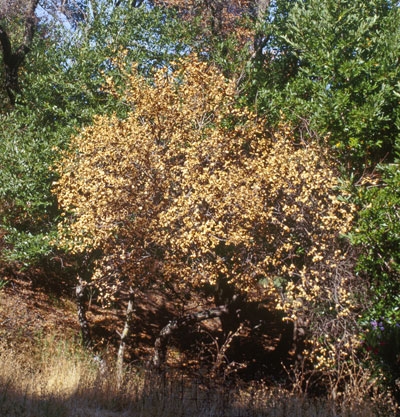
Posts Tagged: Matteo Garbelotto
Sudden oak death continues to spread in California

Warm weather seems to be keeping SOD out of the Salinas Valley, but it is having a deadly effect on the surrounding forests.
“The organism has a really significant impact on our forests,” said Matteo Garbelotto, UC Cooperative Extension specialist in the Department of Environmental Science, Policy and Management at UC Berkeley. He said that adult tanoaks – an evergreen species closely related to oaks – are almost entirely wiped out in some areas.
To help prevent the spread of sudden oak death, people visiting invested areas should not remove leaves or branches and should clean dirt from their shoes before leaving.
Citizen scientists being mobilized in Sonoma County
A Sudden Oak Death "Blitz" planned for Sonoma County June 15-16 will prepare local residents to spot infected plants, collect samples from their neighborhoods and submit them for laboratory testing, reported the Kenwood Press.
The session is hosted by UC Cooperative Extension Master Gardeners and Matteo Garbelotto, UCCE specialist in the Department of Environmental Science, Policy and Management at UC Berkeley.
Trees susceptible to sudden oak death include California bay laurel, tan oak, live oak, black oak, canyon live oak and shreve oak. After the laboratory analysis is complete, Garbeletto will schedule a return visit to discuss the findings of the survey and provide guidelines for action.
"If the disease front is 100 yards away, then one needs to decide whether some of his oaks should be protected," Garbeletto said. "For oaks up to 30 inches in diameter, removal of small and medium size laurels for a 10-yard radius around the oak trunk plus the application of AgriFos on the bark each year or every other year will protect the oak."
The information collected by the citizen scientists will also be added to Garbelotto's OakMapper website, a portal where SOD appearance in California is monitored.

An image from the Oak Mapper website (oakmapper.org) where citizen-submitted scientific data is collected.
Sudden oak death expands in San Francisco Bay Area

Diseased trees were even found in Golden Gate Park, where there is no obvious source of the pathogen, such as nurseries or wildland.
"It's puzzling that we found it there because it's a totally urban environment, and I really didn't expect it. It shows how complicated and adaptable this organism is," said Matteo Garbelotto, UC Cooperative Extension specialist in the Department of Environmental Science, Policy and Management at UC Berkeley. "The area doesn't have a lot of oaks, so I'm not worried about oaks there, but I'm worried about other plants being infected and, of course, people carrying it on their shoes."
Long Beach garden continues to flourish

Called "The Growing Experience," the garden supports a Community Supported Agriculture program, which supplies weekly boxes of fresh produce to families who pay a subscription fee.
“The box of food contains seasonal produce,” said garden coordinator Jimmy Ng. “Right now, we have a lot of collard greens, summer and winter squash, apples, herbs, basil, beets, turnips and we also have eggs.”
The Growing Experience also sells food to gourmet restaurants.
Deadly oak scourge threatens Burlingame Hills trees
Michele Ellson, San Francisco Examiner
Burlingame Hills homeowner Steve Epstein is on a quest to eradicate the Sudden Oak Death in this densely forested canyon enclave of 426 homes west of Hillsborough.
UC Berkeley scientist surprised by SOD incidence
The Forest Pathology and Mycology Laboratory at UC Berkeley used 10,000 tree and plant samples collected by 500 citizens between April and June to document a dramatic increase in the Sudden Oak Death infection rate from Napa to the Carmel Valley, according to the San Francisco Chronicle.
"We found that the number of positives were double and in some cases triple what they were last year," said Matteo Garbelotto, the UC Berkeley forest pathologist who organizes the annual surveys. "We were surprised. That was a big jump."
Old Farmer's Almanac: 220 years of useful advice
Sam McManis, Sacramento Bee
The Sacramento Bee ran a feature story yesterday about the 220-year-old "Old Farmer's Almanac." The article said that most readers of the publication these days are not farmers. When the Bee contacted the California Farm Bureau Federation to find farmers who use the almanac as part of their work or even just for entertainment, its spokeswomen suggested asking Chuck Ingels, farm advisor and director of UC Cooperative Extension in Sacramento County.
"I honestly have never looked at the almanac, but I've seen it on bookshelves," Ingels said. "It's never mentioned by the farmers I'm in contact with."

Dramatic increase in Northern California Sudden Oak Death.